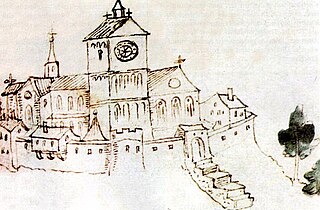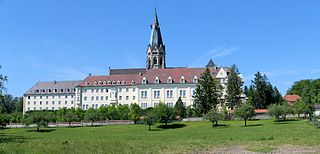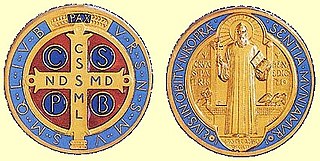
The Abbey of Saint Gall is a dissolved abbey (747–1805) in a Catholic religious complex in the city of St. Gallen in Switzerland. The Carolingian-era monastery has existed since 719 and became an independent principality between 9th and 13th centuries, and was for many centuries one of the chief Benedictine abbeys in Europe. It was founded by Saint Othmar on the spot where Saint Gall had erected his hermitage. The library of the Abbey is one of the oldest monastic libraries in the world. The city of St. Gallen originated as an adjoining settlement of the abbey. Following the secularization of the abbey around 1800, the former Abbey church became a Cathedral in 1848. Since 1983 the abbey precinct has been a UNESCO World Heritage Site.

The epithet Nazarene was adopted by a group of early 19th-century German Romantic painters who aimed to revive spirituality in art. The name Nazarene came from a term of derision used against them for their affectation of a biblical manner of clothing and hair style.

Marie Ellenrieder was a German painter known for her portraits and religious paintings.

Beuron Archabbey is a major house of the Benedictine Order located at Beuron in the upper Danube valley in Baden-Württemberg in Germany.

The Beuronese Congregation, or Beuron Congregation, is a union of mostly German or German-speaking religious houses of both monks and nuns within the Benedictine Confederation. The congregation stands under the protection of Saint Martin of Tours.

Weingarten Abbey or St. Martin's Abbey is a Benedictine monastery on the Martinsberg in Weingarten near Ravensburg in Baden-Württemberg (Germany).

Saint Meinrad was a hermit and is a Roman Catholic and Eastern Orthodox saint. He is known as the "Martyr of Hospitality". His feast day is 21 January.

The Ottilien Congregation, often also known as the St. Ottilien Congregation and as the Missionary Benedictines, is a congregation of religious houses within the Benedictine Confederation, the aim of which is to combine the Benedictine way of life with activity in the mission field.

Karl von Blaas was an Austrian painter known for his portraits and religious compositions executed on canvas as well as in the form of frescoes.

The Beuron art school was founded by a confederation of Benedictine monks in Germany in the late 19th century.

Alexander Maximilian Seitz (1811-1888) was a German painter.

Johannes Sixtus Gerhardus (Jan) Verkade, afterwards Willibrord Verkade O.S.B., was a Dutch Post-Impressionist and Christian Symbolist painter. A disciple of Paul Gauguin and friend of Paul Sérusier, he belonged to the circle of artists known as 'Les Nabis.' Of a Dutch anabaptist background, his artistic and spiritual journey led him to convert to Roman Catholicism, and to take Holy Orders as a Benedictine monk, taking the religious name Willibrord. He entered the Archabbey of Beuron and continued his work in a religious context, working closely with Desiderius Lenz, leader of the Beuron Art School. He worked throughout Europe and had an important influence on the continuing development of the new Benedictine Art.

Gabriel Wüger was an artist and a Benedictine monk. He was one of the founders of the Beuron Art School in Germany in the late nineteenth century.
Friedrich V of Zollern nicknamed, the Illustrious was a Count of Zollern.

Peter Lenz (1832–1928), afterwards Desiderius Lenz, was a German artist who became a Benedictine monk and together with Gabriel Wüger was a founder of the Beuron Art School. Peter was his birth name, but Desiderius became his name when he entered religious orders in 1872. The name was presumably given in reference to the eleventh-century Abbot Desiderius of the Abbey of Monte Cassino, the source of the Benedictine Order.

Adolf Gottlob Zimmermann was a German painter. He belonged to the Düsseldorf branch of the Nazarene movement.

Theodor Markus Rehbenitz was a German painter and draftsman, associated with the Nazarene movement.

Ludovico Seitz, or Ludwig Seitz was an Italian painter of German ancestry, who served as Director of the Vatican Galleries.
Max Schmalzl was a German Redemptorist lay brother who worked as a painter, illustrator, and designer in the style of the Nazarene and the Beuron schools. His intricate woodcuts and illustrations are ubiquitous in Catholic missals and devotional volumes from the late 1800s and early 1900s.
















